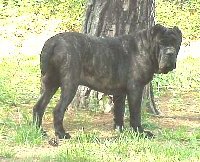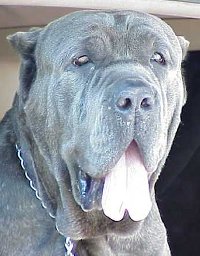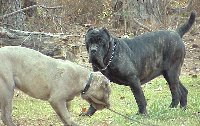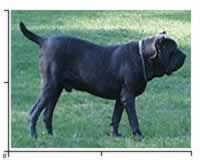| |
| |
| |
Below you will find all the information
you need regarding the history and details of
this excellent animal. You can also enlarge any
of the origin maps below by clicking on them.
|
|
 |
The Neapolitan Mastiff is a serious, powerful,
looking dog. It is muscular with a rather rectangular
body, massive head, and wrinkled face. The facial wrinkles
continue under the chin and down the neck to form a
prominent dewlap. The skull is broad and flat on top,
and the nose is large. The teeth meet in a scissors
or level bite. According to tradition established when
the dogs were used in combat, the ears should be docked
short and the very thick tail is cropped by one third,
although the ears may be kept natural. The short, harsh
coat is dense and smooth. The most common coat color
is blue, though black is the next most common color.
Chocolate dogs are rare. The Neo can be either solid
or brindle. The dark colors and brindles help the Neo
blend into the night shadows as he waits for the unsuspecting
prowler. A little white is permitted on the chest and
toes. No white should be on the face. Puppies begin
life with blue eyes, which later darken. Adult Neo eyes
vary with the color of their coat. Dewclaws should be
removed. The Neapolitan Mastiff has a loose, rolling,
cat-like gait.
|
 |
Despite the beastly and even vicious appearance,
the Neapolitan Mastiff is a peaceful and steady dog.
It was developed to look and act fearsome when needed,
but is affectionate with his family and the family's
friends. Highly protective and fearless. It is extremely
intelligent and somewhat willful. It does not require
repetitious training. Neo's are very attuned to his
master's wishes. This breed rarely gives trouble by
excessive barking. They are serious, calm and quiet
unless provoked. The breed is very wary of strangers.
Males can be much more aggressive and dominant than
females. The Female makes a better family pet, as she
is more submissive to her master and better with children.
|
|
These dogs are, however, usually very loving
with children, provided they do not tease them. Males
do not get along with other males, but the Neo can get
along well with non-canine pets if raised with them
from puppyhood. The Neapolitan Mastiff is not a breed
for everyone. They must have a dominant owner capable
of controlling him properly. Owner dominance should
be firmly established while the dog is young.
|
 |
|
Children should be taught to respect these dogs. Neapolitan
Mastiffs should be well socialized at an early age to
avoid over-protectiveness. They will be quite protective
even with extensive socialization. Additional protection
training is unnecessary because they are naturally guard
dogs. Thorough obedience training is highly recommended.
Be sure you are consistent in approach and do not keep
repeating commands it has failed to obey. These are
not dogs for beginners but it is an exaggeration to
describe them as difficult in their association with
others. A calm handler with natural leadership will
achieve the best results. With thorough training and
an experienced, dominant owner, the Neapolitan Mastiff
can be a good family dog. The Neo is generally very
tolerant of pain due to the breed's early fighting background.
Males often drool quite heavily. They tend to drool
more in hot weather or after drinking water. Adult Neo's
eat about 8-10 cups of dog food a day. If you are planing
on showing your dog, be sure to select a puppy that
has a good temperament so he can accept handling by
strangers.
Back to Top
|
 |
Height: Dogs 26-30 inches (65-75 cm.) Bitches
24-28 inches (60-70 cm.)
Weight: Up to 165 pounds (74 kg.)
The largest male Neapolitans may be nearly 200 pounds
(90 kg.)
Life Expectancy: Up to 10 years.
|
Back to Top
|
|
All European Mastiffs are descended from the
Tibetan
Mastiff, the most ancient member of the canine species.
The first Asian mastiffs were probably brought to Greece
from India by Alexander the Great around 300 B.C.
|
|
The Greeks introduced the dogs to the Romans,
who adopted them enthusiastically and used them in circus
combats. The word "Mastiff" derives from the
Latin word: masssivus, meaning massive. English experts,
however, have another theory. They contend that the
mastiff was brought to Britain by the Phoenicians in
about 500 B.C. and spread from there to the rest of
Europe.
In any case the Neapolitan Mastiff is a direct descendant
of the Roman Molossus. While the breed became extinct
throughout the rest of Europe, it continued to survive
in Campania despite the perils of weather and war. One
can therefore say that the Neapolitan Mastiff has existed
in Campania for two thousand years, even though it was
not officially recognized until 1946, and its standard
was not set until 1949. The Neapolitan Mastiff was bred
for use in war and in bloody Roman arena spectacles.
|
|
|
|
Today this powerful breed has a well-deserved
reputation as a formidable guard dog. Neos have been
used by the Italian police and army and by that country's
farmers, business establishment, and estate owners to
protect people and property. Though the Neapolitan Mastiff
was first shown in Italy
in 1946, the breed is still quite rare in the United
States.
|
Back to Top
© 1999-2001
All rights reserved. Breed information on this page
is provided with permission by
The Dog Breed Info Center http://www.dogbreedinfo.com
|
|
|
|
|
